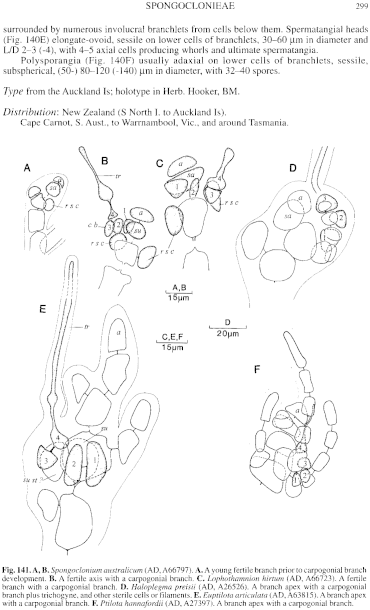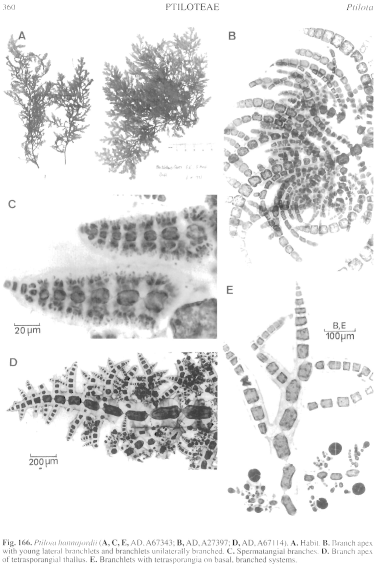|
|
|
|
|
|||||||||||
|
Electronic Flora of South Australia Species Fact Sheet
Phylum Rhodophyta – Order Ceramiales – Family Ceramiaceae – Tribe Ptiloteae
Selected citations: J. Agardh 1876: 80. De Toni 1903: 1381. Lucas 1909: 50. Sonder 1881: 11.
Synonym
Antithamnion hannafordii (Harvey) J. Agardh 1892: 20.
Thallus (Fig. 166A) erect, medium to dark red, 10–35 cm high, densely branched for 4 or 5 orders, with major laterals more or less complanately situated, apices with dense, ecorticate, branchlets, laterals becoming densely corticated some distance below the apices, axes and laterals terete, denuded below, 0.5–1.2 mm in diameter. Holdfast conical, rhizoidal, 3–8 mm across, bearing 1–3 axes; epilithic or epiphytic (on Doxodasya). Structure. Ecorticate tufts clothing and overtopping apices, apical cells 10–15 µm in diameter and L/D 0.8–1.5, divisions oblique, with subapical cells producing 4 lateral branchlets (Fig. 166B), opposite ones in plane of thallus branching developing further; branchlets curved, pinnate, becoming bipinnate, with mostly opposite (–4) pinnules but uniaxial or more developed on the convex side (Fig. 166B); branchlets 700–1200 µm and 10–18 cells long, lower cells 50–150 µm in diameter and L/D 1–1.5, pinnules 80–220 µm and 5–12 cells long, lower cells 25–50 µm in diameter and L/D 0.8–1.2, tapering near their ends to mucronate apical cells 9–16 µm in basal diameter and L/D 1.0–1.2. Cortex becoming several cells thick, pseudoparenchymatous, outer cells isodiametric, 20–30 µm across and bearing a tomentum of anticlinal filaments 50–400 µm and 3–12 cells long, simple or branched, terminal cell mucronate. Cells multinucleate; rhodoplasts discoid, in reticulate chains in larger cells.
Reproduction: Gametophytes dioecious. Procarps (Fig. 141F) borne on subapical cells with a supporting cell bearing a 4-celled carpogonial branch. Carposporophyte with 1–3 subspherical gonimolobes 200–600 µm across, with ovoid carposporangia 10–27 µm across, surrounded by ecorticate branchlets. Spermatangial organs (Fig. 166C) lanceolate, 35–55 (–90) in basal diameter and 90–140 (–250) µm long, with 8–14 axial cells cutting off numerous cells radially and outer spermatangia forming a dense surface layer.
Tetrasporangia (Fig. 166D, E) on branched clusters of smaller cells on lower cells of pinnules, terminal and pedicellate, subspherical, 40–60 µm in diameter, tetrahedrally divided.
Type from Lady Bay, Warrnambool. Vic. (Hannaford); lectotype in Herb. Harvey, TCD.
Selected specimens: Port Elliot, S. Aust., drift (Parsons, 15.i.1968; AD, A32263). Robe, S. Aust., on Sonderopelta; drift (Womersley, 29.viii.1949; AD, A11037) and drift (Wollaston, 13.iii.1955; AD, A19909). Stinky Bay, Nora Creina, S. Aust., drift (Womersley, 26.x.1996; AD, A67114). Blackfellows Caves, SE S. Aust., on Doxodasya bulhochaete, drift (Womersley, 29.ix.1996; AD, A66639) and drift (Hotchkiss, 3.xi.1997; AD, A67343). 1.3 km off Middle Point, Cape Northumberland, S. Aust., 14 m deep (Shepherd, 13.iii.1975; AD, A46205). Port MacDonnell, S. Aust., drift (Womersley, 19.viii.1953; AD, A18980 and 18.ix.1993; AD, A63028). Pirates Bay, Tasman Pen., Tas., 8–10 m deep (Gowlett-Holmes, 23.iv.1995: AD, A64443). Fluted Cape, Bruny I., Tas., 23 m deep (Shepherd, 12.ii.1972; AD, A41922).
Distribution: Port Elliot, S. Aust., to Warrnambool, Vic., and SE Tasmania.
Taxonomic notes: P. hannafordii clearly does not belong to Ptilota, differing in apical development, arrangement of laterals, degree of cortication, and form of the spermatangial branchlets.
P. hannafordii was doubtfully placed in Ptilota by Harvey (1862, pl. 221) and is currently being studied in detail by Dr Gerry Kraft, who will be placing it as a new genus.
References:
AGARDH, J.G. (1876). Species Genera et Ordines Algarum. Vol. 3, Part 1- Epicrisis systematic Floridearum, pp. i-vii, 1–724. (Weigel: Leipzig.)
AGARDH, J.G. (1892). Analecta Algologica. Acta Univ. lund. 28, 1–182, Plates 1–3.
DE TONI, G.B. (1903). Sylloge Algarum omnium hucusque Cognitarum. Vol. 4. Florideae. Sect. 3, pp. 775–1521 + 1523–1525. (Padua.)
HARVEY, W.H. (1862). Phycologia Australica. Vol. 4, Plates 181–240. (Reeve: London.)
LUCAS, A.H.S. (1909). Revised list of the Fucoideae and Florideae of Australia. Proc. Linn. Soc. N.S.W. 34, 9–60.
SONDER, O.W. (1881). In Mueller, F., Fragmenta Phytographiae Australiae. Supplementum ad volumen undecinum: Algae Australianae hactenus cognitae, pp. 1–42, 105–107. (Melbourne.)
The Marine Benthic Flora of Southern Australia Part IIIC complete list of references.
Publication:
Womersley, H.B.S. (24 December, 1998)
The Marine Benthic Flora of Southern Australia
Rhodophyta. Part IIIC. Ceramiales – Ceramiaceae, Dasyaceae
©State Herbarium of South Australia, Government of South Australia
Illustrations in Womersley Part IIIA, 1998: FIGS 141F, 166.

Figure 141 enlarge
Fig. 141. A, B. Spongoclonium australicum (AD, A66797). A. A young fertile branch prior to carpogonial branch development. B. A fertile axis with a carpogonial branch. C. Lophothamnion hirtum (AD, A66723). A fertile branch with a carpogonial branch. D. Haloplegma preisii (AD, A26526). A branch apex with a carpogonial branch plus trichogyne, and other sterile cel Is or filaments. E. Euptilota articulata (AD, A63815). A branch apex with a carpogonial branch. F. Ptilota hannafordii (AD, A27397). A branch apex with a carpogonial branch.

Figure 166 enlarge
Fig. 166. PriIota hannafordii (A, C, E, AD, A67343; B, AD, A27397; D, AD, A67114). A. Habit. B. Branch apex with young lateral branchlets and branchlets unilaterally branched. C. Spermatangial branches. D. Branch apex of tetrasporangial thallus. E. Branchlets with tetrasporangia on basal, branched systems.

|
Email Contact: State Herbarium of South Australia |

|